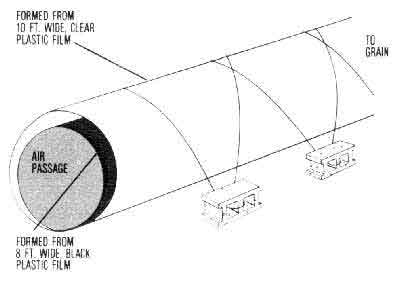
Introduction Adaptability of Drying Systems to Solar Energy Characteristics of Solar Energy Economics of Solar Grain Drying Ways to improve cost effectiveness Determining Solar Heat Availability Collector tilt Types of Solar Collectors Plastic collectors Bare-plate collectors Covered-plate collectors Suspended-plate collectors Transporting Collected Heat Sizing the Solar Collector Solar Grain Drying System Design Examples Full-bin, low-temperature system Layer drying system with grain stirring Summary of Management Considerations in Solar Grain Drying
Corn requires more energy for artificial drying than any other crop. In fact, it often takes more energy to dry corn than it does to prepare the seed bed, plant, cultivate and harvest.
Being Indiana's largest cash crop, most farmers try to harvest their corn within a concentrated few weeks in the fall in order to minimize field losses. Thus, it is usually harvested with more excess moisture than other grains, which explains the high energy requirement for drying.
In Indiana, the energy used to dry corn is estimated at 7.65 trillion BTUs per year-a fuel equivalent of 85 million gallons of LP gas! A rather significant amount of this fuel equivalent could be provided by solar energy. `Tapping into the sun' would not only help conserve dwindling fossil fuel supplies, but also hold down your drying costs in the face of increasing fuel prices.
The purpose of this publication is first to help you evaluate the potential of solar grain drying for your farm enterprise, including where it works or doesn't work, economic considerations, and facility and equipment requirements. Then we will present suggested procedures for determining solar grain drying system design specifications and review the management needed to insure efficient operation.
Generally, high-speed, high-temperature drying is not adaptable to solar energy use for three main reasons. (1) Simple solar collectors cannot provide a high enough drying temperature; (2) the amount of collector surface required to supply all the heat for even a moderate size high-temperature dryer is unrealistically large (nearly an acre); and (3) solar energy is available only when the sun shines. If you already have a large collector, such as a roof unit for warming livestock shelters, it might be used advantageously with high-speed dryers to pre-heat the drying air a few degrees.
Low-temperature drying, on the other hand, is quite well adapted to solar energy. Being a slow process which uses natural or slightly heated air to dry the grain while in storage, solar energy can provide the supplemental heat to raise the temperature and reduce the relative humidity of the drying air.
Solar energy is also applicable to combination high- and low-temperature drying. Under this system, a high-speed, high-temperature dryer is used first to bring the high-moisture harvested grain down to about 20-22 percent moisture. Then the grain is transferred--without cooling--to a slow-speed dryer for final drying to its proper storage moisture content, using natural or solar heated air. The aim of this combination system is to reduce grain moisture quickly to a level where cheaper low-temperature drying can be done without danger of undue spoilage.
Solar energy has four principal characteristics that affect its adaptability to grain drying-(1) it is a diffuse, low-grade energy; (2) it is available at the point of use; (3) it is intermittent; and (4) it is capital intensive. Let's see what bearing these attributes might have on grain drying requirements.
* Direct collection of diffuse, low-grade solar energy produces only a moderate rise in temperature; but this is usually sufficient to meet the requirements for low-temperature drying. Air entering a solar collector for an in-storage drying system is heated only a few degrees. Since heat loss is proportional to the average difference between ambient (outdoor) and collector temperatures, the losses from collectors used in low-temperature drying are small. Therefore, relatively low-cost collectors are effective for grain drying.
* Because solar energy is available everywhere, it can be collected and used at the points of greatest need and/or convenience. That means the collectors can be right where the bins are, whether by the highway or in the back forty. For crop drying applications, there appears to be little economy of scale in the collection and use of solar energy.
* The fact that solar energy collection is intermittent (i.e., available only when the sun shines) poses less of a problem in drying grain than in comfort heating of a livestock shelter or a home. Solar energy is collected during daylight hours only, which means variation in drying potential between day and night. But because low-temperature drying takes several days, the grain can tolerate the varying levels of heat input. `Excess energy' is stored in the form of over-dried grain, which at night will absorb excess moisture from high-humidity air, so that drying can proceed. In effect, the batch of grain being dried provides its own solar heat storage.
* The most serious obstacle to the use of solar energy for grain drying is its capital intensiveness--i.e., a high initial investment is required but operating cost is low. This and other economic aspects of solar grain drying are discussed next.
The investment in equipment for solar grain drying is difficult to justify on the basis of fuel savings alone, even at 1980 prices. Consider the following:
For corn drying, a collector is used a maximum of 8 weeks or 56 days. Using 700 BTUs per square foot of collector as the average heat output during the fall drying season, the total heat supplied in that 8 weeks is 39,200 BTU/sq.ft. (700 BTU/sq.ft. x 56 days). This is about three-tenths of a gallon of fuel oil or a little over four-tenths gallon of propane. Thus, at a price of $1 per gallon, the fuel savings for the season would be only 30-40 cents per square foot of collector.
If we consider only investment payback and assume a 10-year life for the collector, then the collector can cost only $3-4 per square foot. This amount might cover the cost of building a collector into the roof and sidewall of a new machinery shed or livestock shelter, but would not pay for a free-standing collector.
Compared to electricity, solar costs are slightly more favorable. Let's assume that you can build a reasonably-efficient suspended plate collector for $5 per square foot. If used 56 days at 700 BTU/sq.ft. per day, the heat energy produced would again be 39,200 BTUs. This is equivalent to 11.5 kilowatt-hours of electricity (39,200 BTU / 3415 BTU/kw-hr.).
With electricity at 5 cents per kilowatt hour, the equivalent value of the solar energy collected is 57.5 cents (11.5 kw-hrs. x $.05/kw-hr). Thus, the initial collector cost is returned in a little less than 9 years.
Not included in the above calculations are repair costs, interest, taxes, etc. But then neither are the possible tax credits for solar systems and any tax write-off for equipment depreciation. More precise economic analyses are difficult at this point, because we do not know how long various types of solar collectors will last or how much repair will be required both important cost factors.
Increasing system application. From this brief examination of solar economics, however, if is evident that fall corn drying with solar energy is not cost-effective, because of its short use-period each year. The collectors obviously need additional work to do, such as drying small grain or hay in summer and soybeans in the fall, or heating residences, farm shops or livestock shelters when not being used for drying corn.
Solar collectors used for 6 months during the heating season should provide heat equivalent to 1 - 1 1/4 gallon of fuel oil for every square foot of collector. At 1980 fuel oil prices, the return would be $1.50 or more per square foot over the year. On this basis, simple collectors suitable for grain drying and other agricultural uses should provide a good payback. However, some of the other applications may require adding a heat storage to the system and a means of recirculating air through the collector. Both are costly additions not needed when only drying grain.
Minimizing collector cost. Throw-away type solar-collectors can help hold the initial cost down. Figure 1 shows such a collector that may require a new plastic cover or other components every year or two, depending on the weather conditions or the service demanded from it. However, low cost in this sense may nut be low cost in the long run.
Taking a tax credit. Solar equipment, like other farm production equipment. qualifies for depreciation and tax investment credit. Also, there are extra solar equipment tax credits available. Since solar credits vary from state to state and may change, keep apprised of your local situation.
All tax advantages reduce the total cost of collecting and using solar energy. However, the personal property tax that is due on March 1 in Indiana may tend to offset other tax advantages.
The first thing you need to know when considering the use of solar energy to dry grain is--How much is available? That answer depends on a number of factors including: (1) the sun's position in the sky at various times of year, (2) the latitude of your farm (40 degrees north latitude in central Indiana), (3) climate conditions that vary from day to day, (4) changes in the amount of solar energy that penetrates the atmosphere, and (5) the characteristics and angle of tilt of the solar collector.
In estimating the amount of heat available to you for drying grain, the two main considerations are the time of year and angle at which the sun strikes the collector surface. Table 1 shows the average solar heat energy (in BTUs per square foot per day) reaching the earth's surface in the Indianapolis area (40 N latitude), measured at the middle of each month.
Of course, the amount of radiation on any given day will vary from the average, depending on whether the sun shines brightly or the sky is overcast. But the solar energy availability estimates given in the table should be sufficient for initial planning purposes.
The figures in Table 1 are average amounts of radiation you can expect to fall on surfaces tilted as indicated. Examine them from the standpoint of your existing or planned buildings, the time of year you will need the heat, and potential uses for solar heat other than drying grain. Remember, while these figures represent heat available, expect to collect only about half that amount. More on that point later.
As can be seen from Table 1, horizontal surfaces are particularly effective in summer, when the sun is high in the sky and when its rays are nearly perpendicular to the ground. This would be the near-optimum collector `angle' for small grain dryers in summer.
By November and December, however, the radiant energy falling on a horizontal surface has dropped off to about a third of the summer level. This is because the sun's rays strike the surface at a greater angle, and the days are shorter and more likely to be overcast.
A typical 4/12 pitch (18-degree slope) roof on a building can serve as a solar collector. But a steeper roof slope allows more solar radiation to be collected in the late fall, when needed for corn drying. In Indiana, that's a 45- to 60-degree slope for October and November.
To take advantage of the efficiencies of this slope, however, usually requires a special roof, a sloped sidewall or a free-standing collector. And, the expense of constructing a special roof slope may negate the potential advantages. On the other hand, a 60- degree slope collector is less easily damaged by hail than a collector with less slope; and snow cover is less likely to be a problem.
Average energy available when angle of
collector with ground is-
----------------------------------------
Horiz. 4/12 Vert.
Month 0 18 30 45 60 90
------------------------------------------------
BTU/sq. ft.- day
January 526 798 927 1034 1081 994
February 797 1151 1195 1287 1306 1119
March 1184 1431 1515 1550 1498 1137
Apr 1481 1605 1616 1553 1403 841
May 1828 1841 1781 1631 1398 684
June 2042 1996 1897 1696 1412 596
July 2040 2018 1933 1747 1481 675
August 1832 1833 1934 1818 1605 885
September 1513 1747 1814 1813 1710 1205
October 1094 1417 1548 1635 1629 1340
November 662 966 1105 1221 1266 1142
December 491 773 906 1024 1082 1017
------------------------------------------------
Buildings with sidewalls sloped at approximately 60 degrees are now commercially available as prefabricated structures. These are nearly perfect for collecting solar heat for fall grain drying, if oriented toward the south.
Don't overlook the possibility for using the vertical sidewall of a south-facing building as a collector for grain drying and space heating. A vertical surface is most effective in late fall when you need heat for these purposes. Also, it is not easily damaged by hail and does not accumulate snow. A vertical wall collector may be shaded from the summer sun by a properly designed roof overhang, thus minimizing summer heat buildup.
The optimum tilt of a collector that is fixed and intended for year-round use is one equal to the latitude where it is used--i.e., 40 degrees in Indiana.
There are solar collectors available that can track the sun. These will capture 10-20 percent more energy than a stationary south-facing collector tilted at an optimum angle. However, because of their complexity, they are much more expensive, and are a poor investment compared to the cost of increasing the size of a fixed collector by 10-20 percent.
If you need more collector area, consider using both the south-facing wall and roof slope.
Since grain drying is done with air, nearly all collectors used for this purpose are air heating types. The discussion in this publication, therefore, will be confined to solar air heating.
The big advantage of a plastic collector is its low cost. For low air flows through shallow depths of grain, the drying fan may be located at the intake end of the tube to inflate it. Otherwise, a separate fan is used to inflate the tube and move air through the collector.

A problem with plastic collectors is what to do with them when not in use. If left outside, the film is subject to damage or deterioration and must be replaced often; if stored inside, labor is required to set up and tear down the collectors. Also, they must be protected from livestock, pets and rodents. These disadvantages may offset their low cost.
Bare-plate collectors are merely non-covered surfaces which absorb solar energy. Air flows through channels underneath and picks up the trapped heat.
An example of a bare-plate collector is a dark colored, metal-roofed building. The roofing sheets serve as the absorbing surface. Air channels beneath the roofing are made by enclosing the spaces between the rafters or girts with plywood, chipboard or insulation. This type of collector is simple and adapts to metal building construction, but is relatively low in collection efficiency (see Table 2).
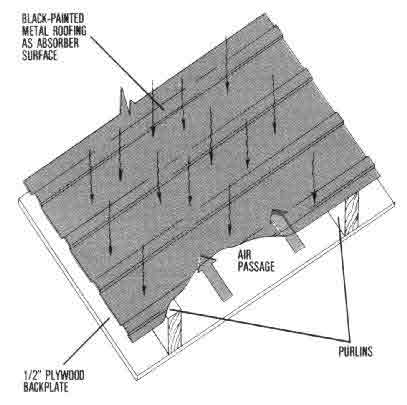
Type Percent efficiency
------------------------------------------------
Bare plate 15-30
Inflated plastic 20-40
Covered plate 30-50
Covered, suspended plate 40-60
------------------------------------------------
*Efficiency is the percent of sun's energy striking the collector that
is converted into heat. It depends on collector design and
orientation, air flow rate, protection from wind, amount of heat loss,
collector length vs. width, and temperature of air entering
collector (usually ambient for grain drying).
Covered-plate collectors are more efficient than the bare-plate collectors. They can be free-standing, built into the buildings or placed on top of existing roofs. The `cover' allows the sun's rays to pass through to the black absorbing surface while protecting it from wind currents that would otherwise increase heat loss. The heat trapped and collected is carried off by the air flowing between the cover plate and absorbing surface (Figure 3).
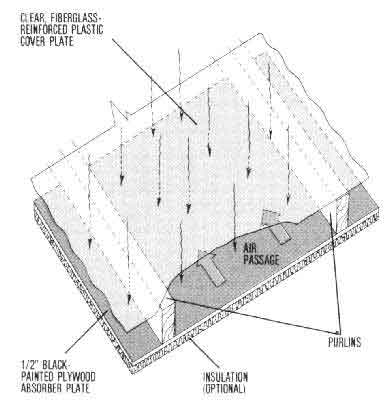
To put a covered-plate collector on an existing roof, simply paint the roof black, place 2x2- or 2x4-inch wood strips or nailers on top of the roof to make channels for the air, and apply clear fiberglass or plastic over the wood strips (Figure 4.)

In designing a new building, the metal exterior roof can be replaced with clear, fiberglass-reinforced plastic to serve as the cover and the entire attic space above the ceiling painted black to serve as the absorber (Figure 5). Or plywood or chipboard is used under the rafters or top truss member, with the side toward the sun painted black. Figure 6 shows a grain bin wall used as a covered-plate collector.
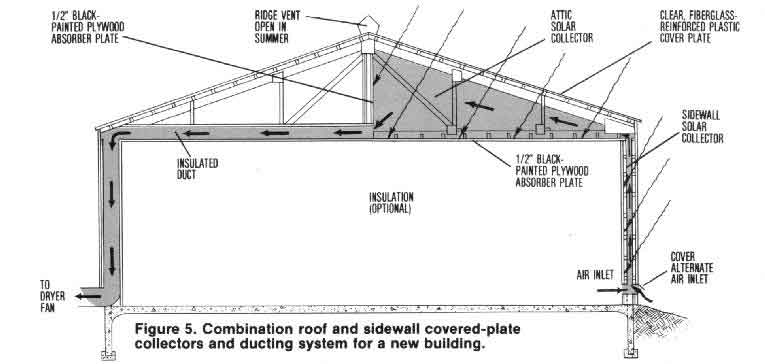
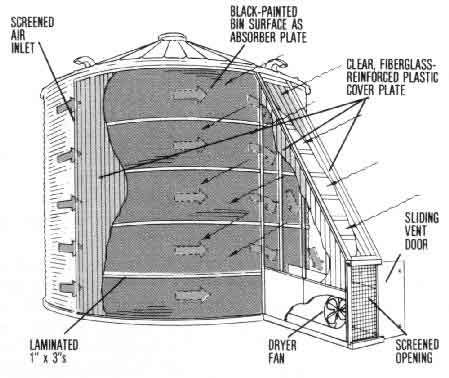
These are more efficient than the covered-plate types, because air flows on both sides of the blackened absorbing surface and less heat is lost (Figure 7). The back and side panels of the collector may be insulated, but the benefit of insulation in suspended-plate collectors used for low-temperature grain drying is small.
Most suspended-plate collectors are free-standing types, and the tilt is usually adjustable. Figure 8 illustrates a free-standing version.
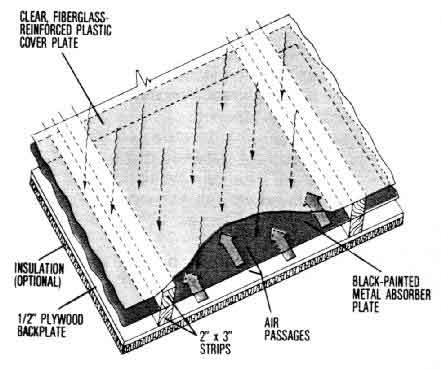
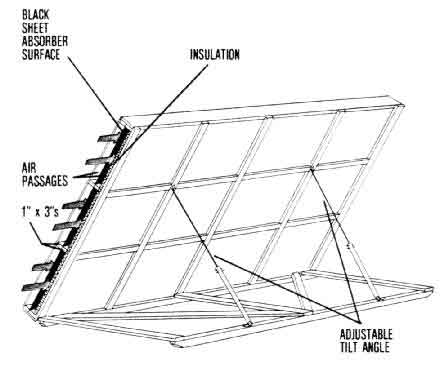
Whether you collect solar energy in the roof or wall of a building, in the sidewall of the grain bin or in a free-standing collector, the solar heated air must be transported to the grain dryer. This can be done using part of the dryer fan energy to pull all or part of the drying air through the collector.
An air duct normally connects the collector to the dryer fan (Figure 5). If the collector is under a slight vacuum, air will flow into it through any leaks, and none of the collected heat will be lost.
It is not always feasible to move all the drying air through the collector, but rather to control the amount that flows through it. This can be done by building a `dog house' over the dryer fan and equipping it with a sliding door to blend outside air with heated air from the collector (Figure 9).
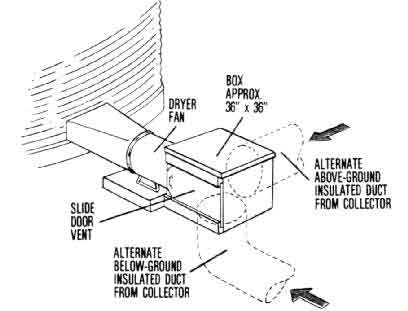
A separate collector fan may be used to either push or pull the recommended amount of air through the collector. This air is then directed toward the air intake of the dryer fan, leaving space for outside air to be drawn into the fan along with solar-heated air (Figure 10). This system requires little management and can be automated by using a time clock to shut off the collector fan at night while the drying fan continues to operate using outside air.
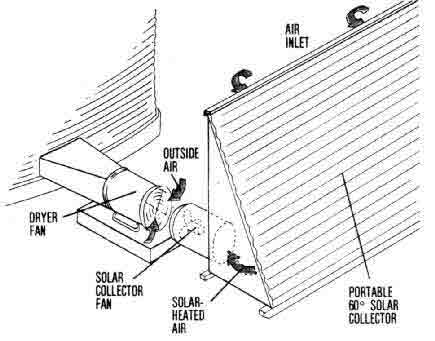
The static pressure required to move air through the solar collector should be limited to not more than 1/2 -inch of water column. The velocity of that air should not exceed 1000 feet per minute. Although more air through the collector increases collection efficiency, it takes more energy and pressure to move that increased air flow. Large drying fans turned on without some way to relieve the negative pressure in a roof collector have been known to cause the collector to collapse.
If a multi-purpose solar collector is used to heat a livestock or workshop area when not drying grain, the air velocity through the collector should be limited to about 500 feet per minute. The reason is that the low-pressure ventilation fans for environmental control are usually not designed to operate at static pressures as high as those encountered in grain drying. In addition, a low velocity will permit the air to be heated to a higher temperature.
For ducts, tunnels and conduits between the collector and fan on the grain bin, provide 1 square foot of duct cross-sectional area per 1 500 cubic feet of air volume. Keep ducts as straight as possible, avoiding sharp turns, and duct lengths as short as possible (preferably less than 100 feet); longer ducts require more horsepower to move the air and have more area for heat loss to occur. Also, insulate collector-to-fan ducts, unless they are located above ground and oriented east-west to serve as additional collector area.
One factor limiting the use of roof, sidewall or similar stationary collectors located on a building for drying grain in a nearby bin is the distance that the heated air has to be moved. The cost of ducting air more than 100 feet, together with the heat losses incurred, may make if more practical to use a separate or movable collector. Besides, a central collector may prevent efficient farm layout.
Solar energy is used in grain drying mainly as a source of heat to supplement that in surrounding air. In full-bin drying, for instance, 50-70 percent of heat for drying comes from the heat already in natural air. An effective solar grain drying system should be able to add 20-40 percent more heat, with the fan contributing another 10-15 percent.
On an average October day, the sensible heat in the air (the heat you can `sense') raises the temperature about 10 degrees above dewpoint. That is, the temperature on the thermometer averages about 10 degrees above what it was in the early morning when dewfall occurred. This accounts for the 50-70 percent of the total drying energy that comes from natural air. The heat from solar energy. then, should be able to raise the temperature of the drying air by about 5 degrees, which represents 20-40 percent of the total heat needed.
How large a collector is needed to capture sufficient solar radiation for a 5-degree temperature rise? To find the answer, first we have to translate that 5 degree rise into heat units (BTUs) per bushel of grain being dried.
1. Assume that the drying air flow rate is 2 cubic feet per minute per bushel (cfm/bu.). The heat required to raise the temperature of 2 cfm of air 5 degrees averaged over a 24-hour day is estimated as follows (1.1 being a constant in the equation):
2 cfm/bu. x 5 F x 1.1 x 24 hrs. = 264 BTU/bu.-day
2. Now assume that a reasonably efficient collector oriented east-west and optimally tilted toward the sun will supply an average of about 700 BTU/sq.ft. of collector area each day during the fall drying season (October 15-November 15). Thus, the collector size needed per bushel of grain dried is calculated as follows:
264 BTU/bu. / 700 BTU/sq.ft. = 0.38 sq.ft./bu.
This is the way the values in Table 3 were determined. The range of collector sizes shown permits larger or smaller temperature increases from solar energy.
The data in Table 3 are a general guide for sizing solar collectors for drying grain. Differences in the sizes specified for the various types of collectors reflect their differences in collection efficiencies, as given in Table 2. The collector areas recommended for the four drying methods listed in Table 3 reflect either the difference in recommended drying air flow rates or temperature rises or both.
Collector type
Drying method (including Maximum ------------------------------------
needed air flow rate and initial Bare- Covered- Suspended-
desired temperature rise) moisture plate plate2 plate
-------------------------------------------------------------------------
percent square feet per bushel
Full-bin/low-temperature 22 1/2 - 1 1/3 - 2/3 1/4 - 1/2
(2 cfm/bu. & 5 rise)
Full bin with stirring 24 1 - 4 2/3 - 3 1/2 - 2
(2 cfm/bu. & 10 rise)
Layer drying with stirring3 26 4 - 10 3 - 7 2 - 5
(10 cfm/bu. & 10 rise)
Batch-in-bin4 28 20 - 30 15 - 20 10 - 15
(15 cfm/bu. & 15 rise)
---------------------------------------------------------------------------
1 Based on average fall heat collection of 700 BTU/sq.ft for suspended plate collector.
2 Includes collectors built into or on building roofs and sidewalls.
3 Based on the number of bushels per layer.
4 Based on drying a 1000-bushel batch in 24 hours.
Here are examples of the procedure that might be followed in the design of a solar grain drying system. The examples are for full-bin/low-temperature and layer drying/grain stirring systems, and involve steps for determining the design requirements of collectors, collector air passages and supply ducts.
Situation. 4000 bushels of shelled corn at 22 percent moisture are to be dried down under this system, which requires a 2 cfm/bu. air flow rate and needs enough supplemental solar heat to provide a 5-degree temperature rise. The collector is a covered-plate type built into a building roof.
1. Collector area. For the covered-plate type collector. Table 3 suggests 1/3 - 2/3 square foot of surface area for each bushel of grain, when used for full-bin, low-temperature drying. Splitting the difference and using 1/2 sq.ft./bu., the total needed collector area at optimum tilt is:
1/2 sq.ft./bu x 4000 bu. = 2000 sq.ft.
2. Adjusted collector area. However, because the collector is on a 4/12-pitch roof, we need to adjust the-collector area to compensate for less-than-optimum tilt during the corn drying season. Table 1 shows that a collector at this tilt will provide only 85 percent as much heat in October as a collector with a 60-degree tilt; and only 75 percent as much in November-an average of 80 percent for the 2 months. Therefore, the collector size needs to be increased by 25 percent [(100% - 80%) / 80%]. Using this figure, we can calculate how much to increase the collector area to compensate for the `poorer' tilt angle:
2000 sq.ft. + (25% x 2000 sq ft.) = 2500 sq.ft
3. Collector dimensions. Suppose the building on which the collector is located is 48 ft. wide by 100 ft. long and oriented east-west. The area of the south-facing half of the roof is about 2600 sq.ft., which includes roof slope and overhang. To accommodate an area of 2500 sq.ft., the collector could be 25 ft. by 100 ft., or perhaps 24 ft. by 100 ft. to better utilize standard building material lengths.
4. Air flow through the collector. The total air flow volume needed for drying is: 4000 bu. x 2 cfm/bu. (from Table 3) = 8000 cfm. Therefore, the air flow rate passing through the collector will be:
8000 cfm / 2500 sq.ft. = 3.2 cfm/sq.ft.
An air flow through the collector of 5 cfm/sq.ft. is considered close to optimum for grain drying. Since 3.2 cfm is less, all the drying air available can be pulled or pushed through the collector. If the south half of the building attic space is painted black and used as the absorber, there would be plenty of room for air to flow through the collector. Provisions should be mace to vent the attic area used as a collector in the summer either with a ridge vent or louvered vents in each gable end.
5. Duct area and dimensions. As mentioned previously. the duct from collector to bin should be under 100 feet in length and have a cross-sectional area such that air velocity in the duct is 1500 fpm or less. Thus, for our example, required duct area is:
8000 cfm / 1500 fpm = 5.33 sq.ft.
To accommodate this required area, a round duct 32 inches in diameter or a rectangular duct about 2 ft. by 3 ft. may be used.
Situation. 4500 bushels of shelled corn at 25 percent moisture are to be dried down in three layers (1500 bushels each) using this system, which calls for a 10 cfm/bu. airflow rate and a 10-degree temperature rise provided by solar heat. The collector is a suspended-plate type, free-standing and tilted during the drying period at an optimum 60 degrees.
1. Collector area. Table 3 shows that, for this type of drying system, a 10-degree temperature input is recommended from solar heat, requiring a suspended-plate collector area of 2-5 sq.ft./bu. Again. using the mid-point for our example, total collector area needed is found to be:
3.5 sq.ft./bu. x 1500 bu. = 5250 sq.ft.
2. Collector dimensions. A collector this large could be made up of three sections, each 12 ft. wide and about 144-148 ft. long (1750 sq. ft.) manifolded together to provide the 5250 sq.ft. needed.
3. Air flow through the collector. The total air volume needed for drying is: 1500 bu. x 10 cfm/bu. = (from Table 3) 15,000 cfm. Thus, the air flow rate through the collector must be:
15,000 cfm / 5250 sq.ft = 2.9 cfm/sq.ft.
While this is lower than the optimum amount of near 5 cfm/sq.ft., air flow must be limited to insure a 10F average temperature rise in the drying air. Thus, all the drying air can be pulled through the collector if air velocity and static pressures do not exceed recommended levels.
4. Area and dimensions of air channel through collector. First, we must find the total air flow rate in each section of the collector:
2.9 cfm/sq.ft. x 1750 sq.ft. = 5075 cfm.
If we keep air velocity through the collector within the recommended 500-1000 fpm range (750 fpm average), the required air channel area in each section will be:
5075 cfm / 750 fpm = 6.8 sq.ft.
Since each collector section is 12 ft. wide, the depth of the air channel must be:
6.8 sq.ft. / 12 ft. = .57 ft. or about 7 in.
Since air is drawn through both sides of the absorber In a suspended-plate collector, the air passage will be 3 1/2 inches deep on each side. This would allow you to use standard 4-inch lumber (which is actually 3 1/2 inches) on each side of the absorber.
5. Duct area and dimensions. Again, holding to the 1500 fpm air velocity maximum in the supply duct from the collector to the drying fan, we calculate cross-sectional area as follows:
15.000 cfm total drying air
--------------------------- = 10 sq.ft.
1500 fpm velocity
A rectangular duct 2.5 ft. wide by 4 ft. high would be adequate, if the duct is very long, consider making it triangular and using the leg of the triangle which faces the sun as additional collector area.
Following is a summary of how solar energy may be applied to grain drying, including management tips to help insure success:
* Solar energy is an excellent alternative source of supplemental heat for low-temperature grain drying systems. Because these systems require only a few degrees additional temperature rise 5-10 F, they are well adapted to the moderate heat increases that solar energy can economically generate. Also, if the temperature rise during midday is substantially above this, the grain will store the excess heat and release it during the night, allowing no drying process to continue.
* The initial moisture level of corn to be dried in a full-bin drying system should not be more than 22 percent, because of the limitations on fan power and air flow, not because of insufficient heat from solar energy. Higher initial moisture contents are permitted if the grain can be stirred or dried in layers or dried in smaller batches at higher air flow rates.
* Solar energy may be used in the low-temperature phase of a combination drying system after the grain is dried to 20-22 percent in a high-speed dryer.
* Continuous drying is best until the moisture content is 15 percent in full-bin systems. Intermittent operation in daytime only may be necessary to reduce the moisture below 15 percent.
*If binned grain is not completely dry but is down to 18 percent of lower moisture by early December, the damp grain can be maintained through the winter by occasional aeration for temperature control. Drying may then be completed the next spring when the humidity is lower and more solar heat is available. If any grain in the bin is above 18 percent moisture, drying must be continued until the wet grain either dried or is fed.
* It is best that the drying air bypass the collector at night. If not, the collector will radiate heat to the cold night sky and cool to below the surrounding temperature any drying air pulled through it. Taking air directly into the dryer fan eliminates the collector's air flow resistance, thus improving drying capacity and saving energy.
* Be sure to provide summer ventilation for solar collectors, especially roof and attic types, to prevent high temperature buildup. Ridge ventilators, gable-end louvers and eave openings will accomplish this. High temperatures cause deterioration of collector fiberglass cover plates and insulation.
* The importance of sealing cracks in the solar collector and distribution system depends on whether the air is pushed or pulled. If pulled, air entering the collector will only reduce the temperature, not the amount of total heat collected and delivered. If air is pushed and the collector and duct system are under pressure, any air leaking from the system is heat lost. This is why pulling air through the collector is preferred.
* Insulate distribution ducts that will lose heat to the outside air or ground with at least 1 inch of insulation to conserve collected heat.
* Cover all air intake openings with 1/4-inch hardware screen to keep out birds and rodents, and practice a good rodent control program.
* If you use the solar grain drying system alternately for livestock space heating and your building roof serves as a solar collector, do not reverse the air through the collector for summer cooling. If you do, odors and dust from the livestock area will be drawn into the collector. Later, when the collector is used again for grain drying, these odors may be transmitted into the grain. Use a separate ventilation system to cool the collector in summer.
* If you build a collector into a machinery shed roof or sidewall, take air into the collector from inside the structure. Inside air warmed by heat radiating from the back side of the collector will be utilized, but provision must be made for air entrances.
* Limit air velocities to about 1000 fpm through the air passages of bare-plate collectors and to 500-1000 fpm through covered- or suspended-plate collectors. Allow 1 square foot of duct cross-section per 1500 cfm of air volume in tunnels and ducts connecting the collector to the dryer fan.
Single copies of the following Purdue Extension Publications are available free to Indiana residents from their county Cooperative Extension Service office or by writing to Media Distribution Center, 301 South Second Street, Lafayette, IN 47901-1232:
"Fan Sizing and Application for Bin Drying/Cooling of Grain" (AE-106)
"Solar Energy Heat Storage for Home, Farm and Small Business" (AE-89)
"Solar Heating for Home, Farm and Small Business" (AE-88)
"Solar Heating Systems for Confinement Livestock Buildings" (AE-99)
The following Midwest Plan Service publication is available at the per-copy cost indicated (1980 price) from the Farm Building Plan Service, Agricultural Engineering Department, Purdue University, West Lafayette, IN 47907:
"Low-Temperature and Solar Grain Drying Handbook" (MWPS-22), $3.00
For more information, contact Dirk Maier, Agricultural and Biological Engineering, phone: 317-494-1175 or e-mail: maier@ecn.purdue.edu
New 8/80
Cooperative Extension work in Agriculture and Home Economics, state of Indiana, Purdue University, and U.S. Department of Agriculture cooperating; HA. Wadsworth, Director, West Lafayette. IN. Issued in furtherance of the acts of May 8 and June 30, 1914. Purdue University Cooperative Extension Service is an equal opportunity/equal access institution